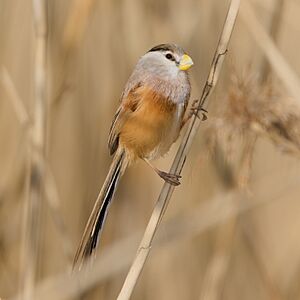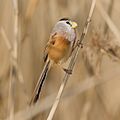Reed parrotbill facts for kids
Quick facts for kids Reed parrotbill |
|
|---|---|
 |
|
| Conservation status | |
| Scientific classification | |
| Genus: |
Paradoxornis
|
| Species: |
heudei
|
| Synonyms | |
|
Calamornis heudei |
|
The reed parrotbill (Paradoxornis heudei) is a small bird that belongs to the family Paradoxornithidae. You can find these birds in Manchuria, eastern China, and the Russian Far East. Sadly, their homes are disappearing, which puts them at risk.
Sometimes, a group of these birds from the north, called P. h. polivanovi, is thought of as a separate species. It's known as the northern parrotbill.
Contents
What Does the Reed Parrotbill Look Like?
Reed parrotbills have short, wide, and deep beaks. They are special because their look changes with the seasons. This change happens between their non-breeding (winter) and breeding (summer) times.
Winter Appearance
In winter, when they are not breeding, their forehead and neck are a mix of pinkish-cream and ash-gray. They have black and warm brown stripes that go from above their eyes to the top of their head. The area between their eyes and beak is a bit whiter than their forehead. A light stripe runs from the base of their beak, over their eye, and towards the back of their head. Their ears are similar in color to the top of their head. Their bodies have different colored stripes, including black and brown. The stripes get darker, becoming blacker, further down their body.
Summer Appearance
In summer, during breeding season, the top of their head and the feathers on their upper back are bluish-gray. The lower part of these feathers is a darker chestnut color. Their ears are a little lighter, and the sides of their body are a lighter chestnut than in winter.
Where Do Reed Parrotbills Live?
Reed parrotbills live in East Asia. Their special home is called a reedbed. A reedbed is a very wet area filled with tall reed plants. It's usually found between water and dry land.
These birds depend on reedbeds for everything. Reedbeds provide them with both water and food. Unfortunately, many reedbeds are being damaged or destroyed. This loss of their natural home is causing the number of reed parrotbills to go down.
What Do Reed Parrotbills Eat?
Reed parrotbills mostly eat insects. One type of insect they enjoy is a pancake-shaped insect called Alceridae. They use their strong beaks to cut open reed stems. This helps them find insects hidden inside. When they do this, they can make very loud noises!
These birds have a unique digestive system. They do not have the back part of their stomach that usually grinds up food. This means they have a hard time digesting tough or hard food items. They lack a strong gizzard muscle, which is what many birds use to grind food.
How Do Reed Parrotbills Reproduce?
Reed parrotbills can raise more than one group of babies in a single season. This is called being "multi-brooded."
Breeding Seasons
They have three main times for laying eggs:
- The first time is from mid-May to mid-July.
- The second time is from mid-July to mid-August.
- The third time is from mid-August to mid-September.
During the breeding season, you will usually find these birds in pairs. They build thick nests, mostly in China. However, their breeding areas are shrinking. New buildings and developments in China are taking away their natural homes. This directly affects their ability to breed, causing their numbers to decline.
Why Are Reed Parrotbills at Risk?
The number of reed parrotbills is expected to drop quickly. This is mainly because their homes, the reedbeds, are being damaged or cleared away.
Globally, they are not considered "threatened" yet. Instead, they are listed as "near threatened." This means they could become threatened soon if things don't change. The biggest dangers to these birds are:
- Clearing away reedbeds for other uses.
- Harvesting too many reeds from their habitat.
The population of reed parrotbills is decreasing fast. There are fewer and fewer adult birds each year.
Images for kids




